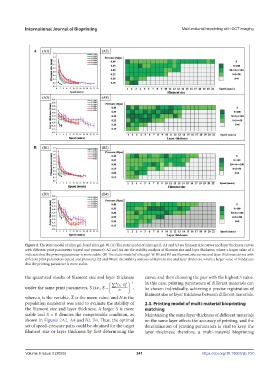Page 249 - IJB-9-3
P. 249
International Journal of Bioprinting Multi-material bioprinting with OCT imaging
Figure 2. The static model of silica gel-B and silica gel-W. (A) The static model of silica gel-B. A1 and A3 are filament size curves and layer thickness curves
with different print parameters (speed and pressure); A2 and A4 are the stability analysis of filament size and layer thickness, where a larger value of S
indicates that the printing parameter is more stable. (B) The static model of silica gel-W. B1 and B3 are filament size curves and layer thickness curves with
different print parameters (speed and pressure); B2 and B4 are the stability analysis of filament size and layer thickness, where a larger value of S indicates
that the printing parameter is more stable.
the quantized results of filament size and layer thickness curve, and then choosing the pair with the highest S value.
X
x i 2 1 In this case, printing parameters of different materials can
N
under the same print parameters, S (i.e., S 1 , be chosen individually, achieving a precise registration of
N filament size or layer thickness between different materials.
where x is the variable, X is the mean value, and N is the
i
population numbers) was used to evaluate the stability of 2.3. Printing model of multi-material bioprinting
the filament size and layer thickness. A larger S is more matching
stable and S = 0 denotes the nonprintable condition, as Maintaining the same layer thickness of different materials
shown in Figures 2A2, A4 and B2, B4. Thus, the optimal on the same layer affects the accuracy of printing, and the
set of speed–pressure pairs could be obtained for the target determination of printing parameters is vital to keep the
filament size or layer thickness by first determining the layer thickness; therefore, a multi-material bioprinting
Volume 9 Issue 3 (2023) 241 https://doi.org/10.18063/ijb.707

